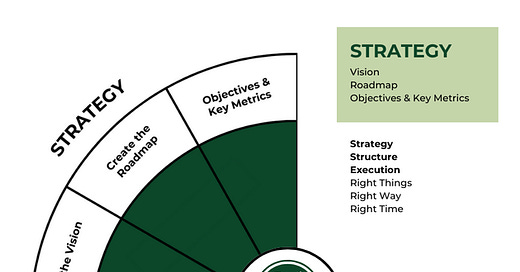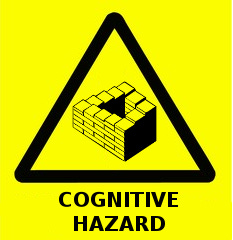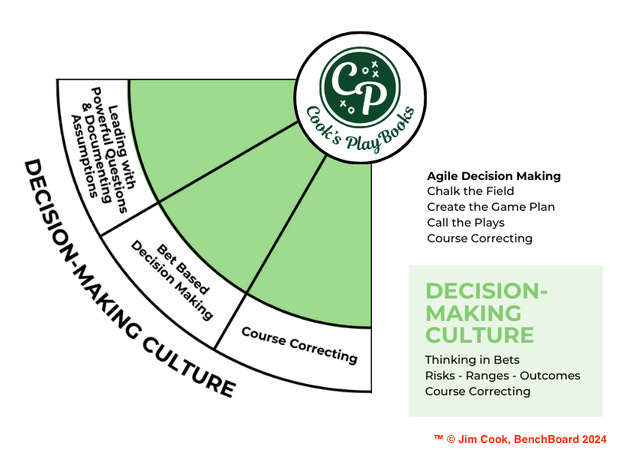Cook’s Coaching Corner: STRATEGY
Covering the Corners: Unpacking my top level coaching framework - corner by corner. First up - the Strategy Corner.
“Hey, Jim. What’s ISN’s Strategy?”
Scott Cook, Intuit’s founder, CEO, and Board Chairman was asking me this question in my 1:1 exit conversation after my first 5 years in Silicon Valley (1991-1996). I had been in the room(s) with Scott and the other exec team members in nearly all of Intuit’s critical early financing moments [1st private round (Kleiner), 1993 IPO, critical mergers like Chipsoft (TurboTax; 1993) and each of the 18 quarterly conference calls as a public company (1993-1996)].
I didn’t have a crisp answer. Scott quickly replied, “You need to figure it out fast!” I was just hired to my first VP role - VP of Finance at ISN in 1996 - and Scott was still coaching and mentoring me in my exit interview. This was a seminal moment in leadership for me. My learning(s) as a newly minted executive were just beginning.
My new company, the Internet Shopping Network (ISN) was literally the very 1st e-commerce company to make an online sale (Oct, 1994), shortly after Netscape’s first browser release and IPO. Several Intuit colleagues and I needed to get back to our entrepreneurial roots after the last three years of being a public company. We began heading to other hot startup companies in the mid-90’s like Netscape, Pointcast, Yahoo!, eBay, Excite, and that other unknown e-commerce company… Amazon. It was an incredible time to start a career in Silicon Valley. This was all before we started Netflix in the fall of 1997.
Definitions: In this and many future posts, I’ll be using a consistent framework to communicate my “Best Ofs” for Cook’s PlayBooks - continuing my “Business as a Sport” metaphor.
GAME PLAN: (a.k.a. Mental models, 1st Principles, Situational Context)PLAYBOOK(s): (various “plays” or options which many times will include the Roles/Positions needed to execute the “play”)CHALKING THE FIELD: (the rules to play by; Dos and Don'ts; Key Lines on the Field of Play which help define inbounds/out of bounds and how to score)SCOREBOARD: (Key Milestones; Metrics; Benchmarks)Top Level Coaching Framework (Last Week’s Post)
Cook’s Coaching Corner: Let’s Unpack - Top Left
Personal Note on the Game Plan; PlayBooks; and Chalking the Field below. I’ve sent a version of this post in email to all@___ from my CFO seat during nearly every planning cycle since that Scott Cook lesson on “Strategy” in 1996. I came to realize many others hadn’t fully learned these critical strategy lessons. Ultimately, my goal then, and now, is to ensure we all start with Strategy and then align it to Structure, and Execution. I encourage each of you in your similar leadership seat to communicate these lessons and to add a few of your own “Best Ofs” and “PlayBooks” to design your own winning Game Plan.GAME PLAN:
(a.k.a mental models, frameworks, situational context)It’s critical to truly understand, define, and align everyone in your company to what STRATEGY actually means (vs. what they may think it means).
What is Strategy? What is Strategy not? How do we win with Strategy? How to lose?
Let’s answer these questions in this installment of Cook’s Coaching Corner:
Specifically, Strategy IS:
an integrated set of choices and decisions
that uniquely positions your company within your industry
in order to create a sustainable competitive advantage
& provide superior value to your customers
Strategy is the practice of figuring out the best way to get from here to there. From current state to future state with “past state” informing your choices and future path decisions.
A great analogy, many of you have likely heard, is worth repeating here:
Imagine you have a car and want to go on vacation where it’s warm. Do you drive North? South? East? Or West? There are so many directional choices. The answer also depends on where you are now! Where you are starting from? Is any warm place good enough? You probably need to define warm as “Beach?" or “Desert?" These are vastly different choices of “Warm.” What are the best routes to get there? Do you have a map? Do you need to create a planned itinerary? Your journey likely depends on what kind of car you have? How many stops will you have to make? (Depends on gas tank size) Where will you sleep on this multi-day journey? How will we pay for stuff along the way? Do we need an emergency kit?
In all of these examples, there are several key aspects that are fundamental to all forms of strategy.
1) Clear vision of where you want to end up
2) An understanding of where you are now
3) An assessment of what stands in between
4) Clear decisions of how to approach the challenge
5) Specific choices, decisions, courses of action to take.
If your Strategy doesn’t address these aspects of the challenge of actually choosing your future path in some way – then you don’t really have a Strategy.
FIVE STEP STRATEGIC GAME PLAN SUMMARY:
1) Strategy = a Set of Choices
Where specifically are you going?
What is your desired outcome/future state when you get there?
What is required to get there?
How fast can we go?
Have we created the roadmap and did we include “milestone markers?”
Have we chosen a specific path for our strategic journey?
2) Planning = Making Specific Decisions About These Choices
Who is leading / driving?
What are our most critical dashboard lights?
How much gas do we have? How much do we need to hit our next milestone?
→ Insert your own powerful questions here: _______
3) Strategy must come FIRST. Your board and leadership team must align on the Strategy. Once aligned, you must stress test the leadership and team org structures to ensure the right people are working on clearly defined strategic objectives to support the Strategy.
4) Operational execution then (and only then) follows. This means properly structuring strategic objectives ownership and accountability. Great operational execution results in fully defining and documenting the priorities & activities (objectives) and measurements (key results) and finally then (and only then) aligning it all to your financial resources and your financial plan.
5) Agility is required. Your strategic plan/roadmap must be stress tested quarterly to decide whether to “stay on course” or more likely and with much higher probability to “course correct.” Your strategic journey/path will unfold in unexpected ways as you face unforeseen obstacles and unexpected opportunities. You must create an agile, course-correcting strategic decision making methodology based on “thinking in bets” (future post coming on this).
THE PLAYBOOK(s)
(various “plays” or options which many times will include the Roles/Positions needed to execute the “play”)
Focus your energy on the key strategic choices to influence your revenue decision makers - P.S. these aren’t internal people… THEY ARE YOUR CUSTOMER! These are the people who will decide to spend their money with your company/product.
Make 2 Choices:
WHERE TO PLAY? (Which specific customers to target and which to not target right now)
HOW TO WIN with those customers
If a Strategy is about just those 2 CHOICES, it won’t need to involve the production of long and tedious planning documents and multiple weeks of “leadership meetings.”
1 Page. Simple Words. Simple Concepts: Where to play and how to win customers keeps the discussion simple and grounded for everyone without going down those distracting rabbit holes.
Strategy is NOT about PERFECTION. We as leaders need to reinforce constantly that we are making strategic bets. Bets by definition win and lose. There is no perfect bet in life, business, or Vegas. The goal is to simply have significantly more wins than losses and to course correct to make smarter bets.
Lead with Powerful Questions, Share and Defend Your Strategic Logic, and Stress Test the Results:
What do we believe about our customers to ensure our Strategy makes sense?
What do we believe about the evolution of our industry to ensure our Strategy makes sense 12+ months from now?
Are we winning vs the competition? How are we winning? How are we losing?
Are our technical capabilities delivering what our customers need and will use? Is there a technological threat or opportunity coming in the next 12 months we need to understand and embrace? [E.g. Windows vs DOS (1991); E-Commerce vs Retail (1999-2009); Cloud vs Data Center Computing (2005-2010); Mobile vs Desktop (2009-2015); SaaS (2015 to today); Impact of AI (tomorrow)]
CRITICAL PLAY: WRITE DOWN (a.k.a Document!) the answers to these questions regularly in a public and visible place for your team and company. Stress test the documented answers regularly. The human mind has a remarkable ability to rewrite history and to declare events unfolded as planned. We have an even better ability to rationalize how strategic bets were made and why. Don’t rewrite history. Create it as it occurs and by doing so learn the lessons of your own history so you don’t repeat those mistakes.
DO THIS INSTEAD: RECORD (a.k.a. Document!) the strategic logic and then compare the written document to actual events. Everyone in the company will be able to quickly see when and how the Strategy is not producing the desired outcome and will begin making recommended adjustments.
AVOID THIS PLAY: Don’t let planning drive STRATEGY. Strategy must always come first and always needs to DRIVE PLANNING. Otherwise human behaviors naturally take over and create an environment where planning dominates Strategy rather than serving it. If you are comfortable with your company’s Strategy, chances are you’re not being strategic enough.
AND THIS PLAY: Don’t ever let execution or structure (org structure) come first and drive Strategy. Strategy must absolutely come first. Org structures and systems must come second. Operational execution must come third. In that order. Every time.
CHALKING THE FIELD
(the rules to play by; the Dos and Don’ts; Key lines on the fields of play to help define the rules and keep score)Don’t approach Strategy as a “problem that can be solved.”
True Strategy is about placing bets and making hard choices of MUST DOs and especially what we MUST STOP DOING to free up resources for what we MUST DO.
True Strategy is uncomfortable and apprehensive.
Great Strategy doesn’t eliminate risk. No risk = no reward. Great Strategy significantly increases the odds of success. Bad Strategy or no Strategy greatly increases the odds of failure.
Strategic planning is NOT STRATEGY; BUT! “your planning” BETTER start with being strategic.
Don’t mistake planning for Strategy. Don’t mistake goals for Strategy:
Many bad strategies are just statements of desires or hopes rather than specific choices and decisions for overcoming obstacles.
“Hope is not a Strategy.”
Beware bad strategic objectives:
Strategic objectives are “bad” when they fail to address critical issues.
Strategic objective are “bad” when they are impractical (e.g technology doesn’t exist, prohibitively expensive, or you are too far ahead of mainstream customers).
Don’t fall into the affordability trap; Don’t create a “financial plan” first and then create what you think is strategy when it’s only a set of initiatives you can afford.
The best “planning” can’t and won’t make revenue magically appear.
Creating revenue plans is an interesting spreadsheet exercise but the much harder job is creating the clear strategies on how to acquire and keep customers.
Beware self-referential strategy frameworks that declare a few paralyzing truths which may be voiced by inexperienced leadership teams.
"We have to wait until predictability is high enough and volatility low enough to start making choices.""We must wait for even more data to increase our probability of success. Make your decisions at 70%-80% of probabilities, not 90-100%."“Best Of” Sources and Further Reading
Good Strategy; Bad Strategy by Richard Rumelt
Quotes from this book:
"A good strategy doesn’t just draw on existing strength; it creates strength through new connected structures, systems, and design.""A good strategy creates new strengths through subtle shifts in viewpoints.""An insightful reframing of the competitive situation to create whole new patterns of advantages and weaknesses.""The most powerful strategies arise from game changing insights."“A BAD STRATEGY SKIPS OVER THE FACT THAT NOBODY IN THE ROOM HAS A CLUE ON HOW TO GET THERE”"BAD STRATEGY FLOURISHES because it floats above analysis, logic, and choice, held aloft by HOPE than once can avoid dealing with these tricky fundamentals and the difficulties in mastering them.""BAD STRATEGY IS THE ACTIVE AVOIDANCE of the hard work in crafting a good strategy."Upcoming Posts (July, 2024)
Over the next 3 weeks, I’ll be finishing the other three Cook’s Coaching Corners covering the rest my Top Level Framework post last week.
Decision Making Systems and Cultures
Leadership Cultures
Influence & Communications
I promise to continue to bring you my “Best Of” content curated from both my own critical lessons learned in my career to the most recent “Best Ofs” on a subject.
Make sure to hit the Subscribe Button right below to ensure you get these posts to your inbox.
Thanks for hitting that button.
Paid Subscribers can leave Comments where we hope to build a great community and collective “Best Ofs.”
Please share this with somebody who may need it with a simple click.
Now here’s a couple of Easter Eggs - “Best Ofs” since you read this far!
Ben Horowitz - the Map and the Terrain
Matt May - the Play-To-Win Canvas and Templates











